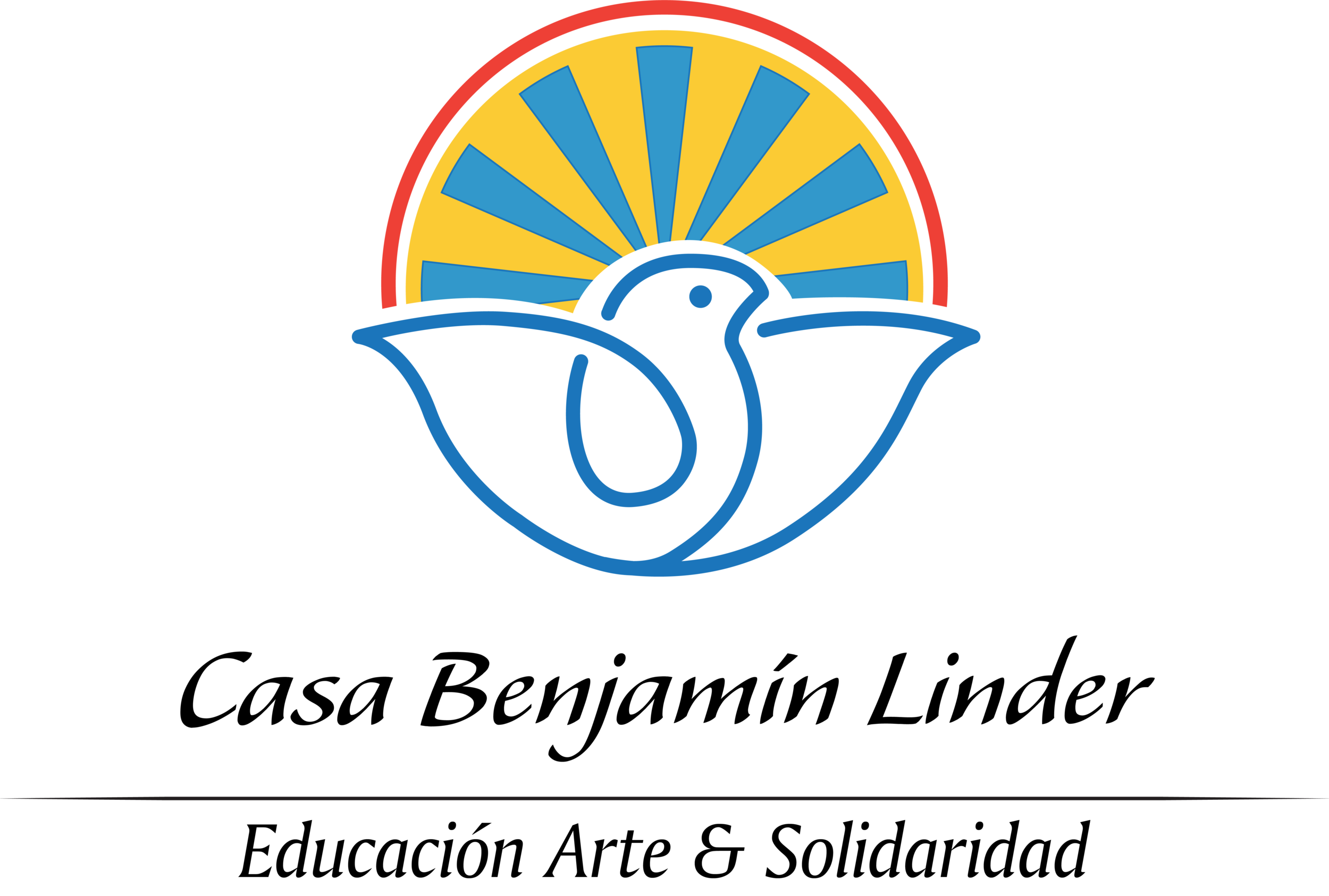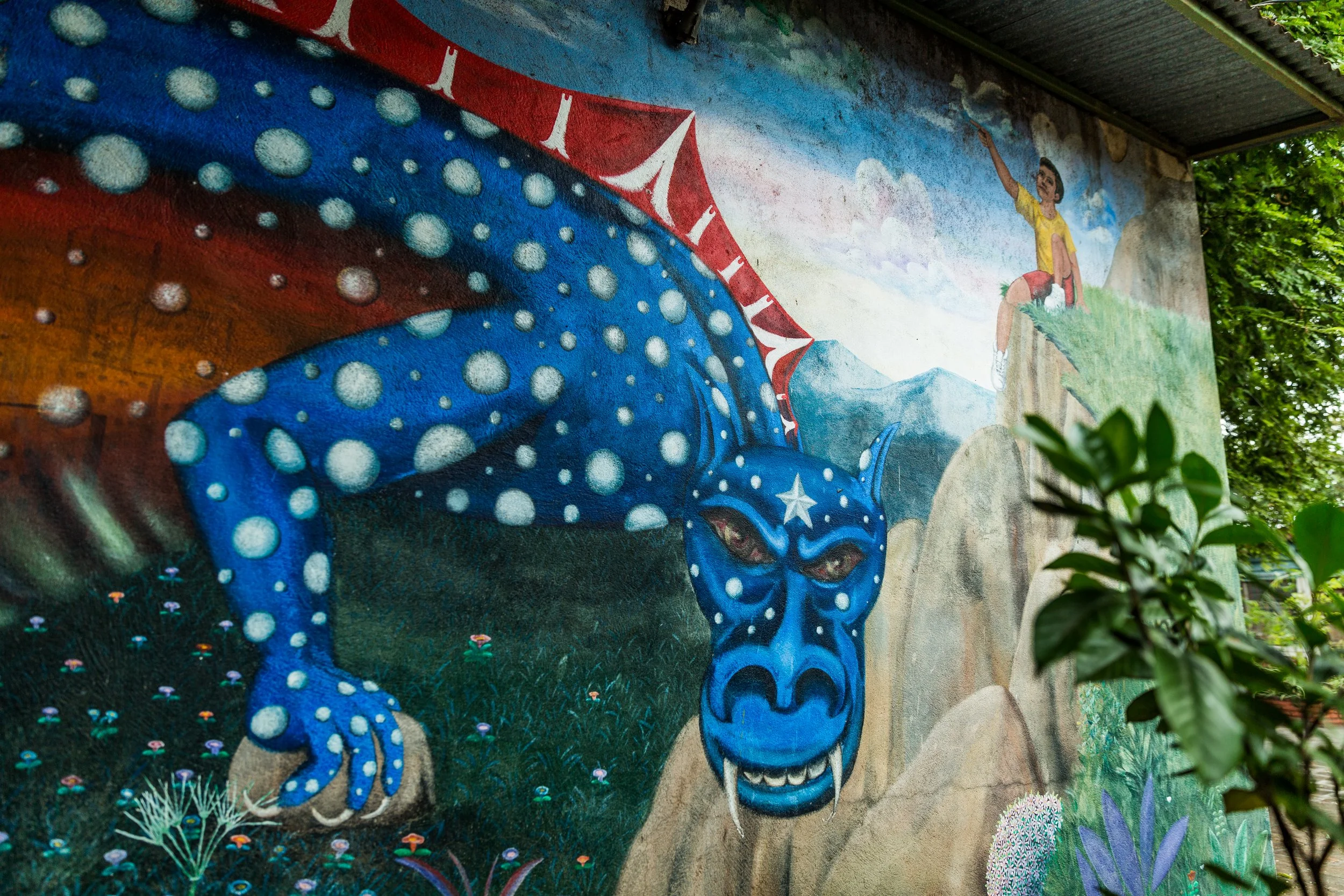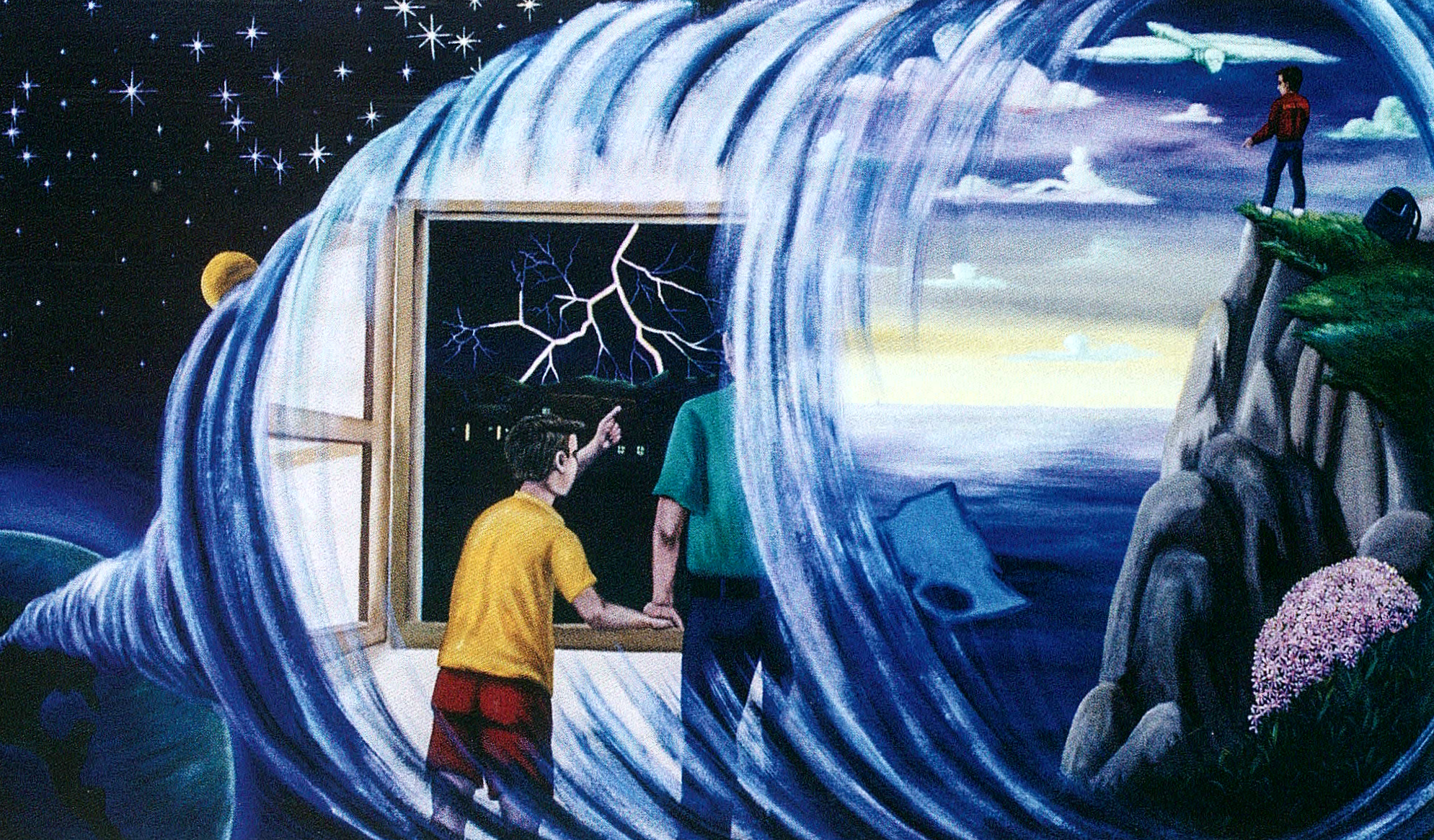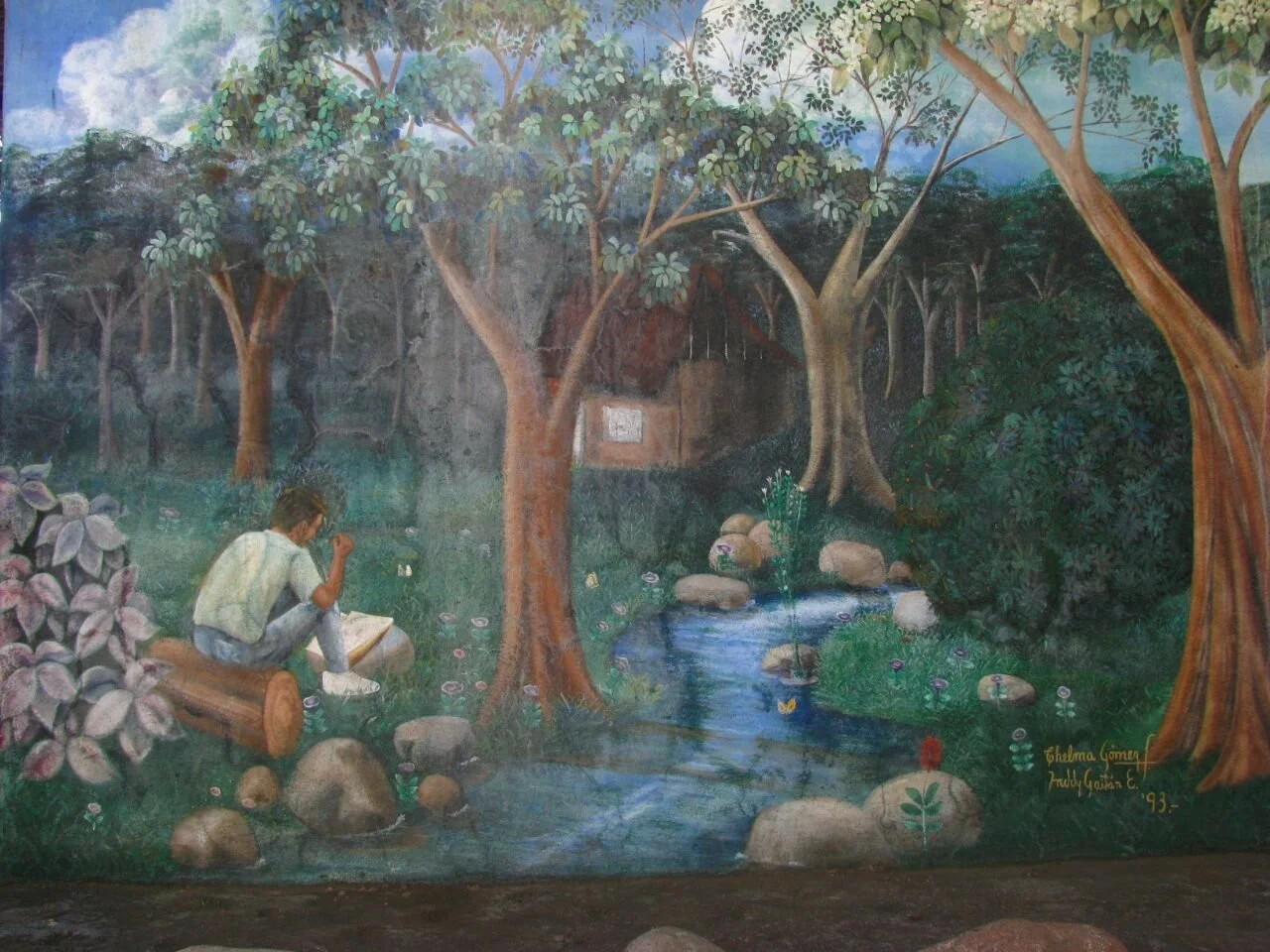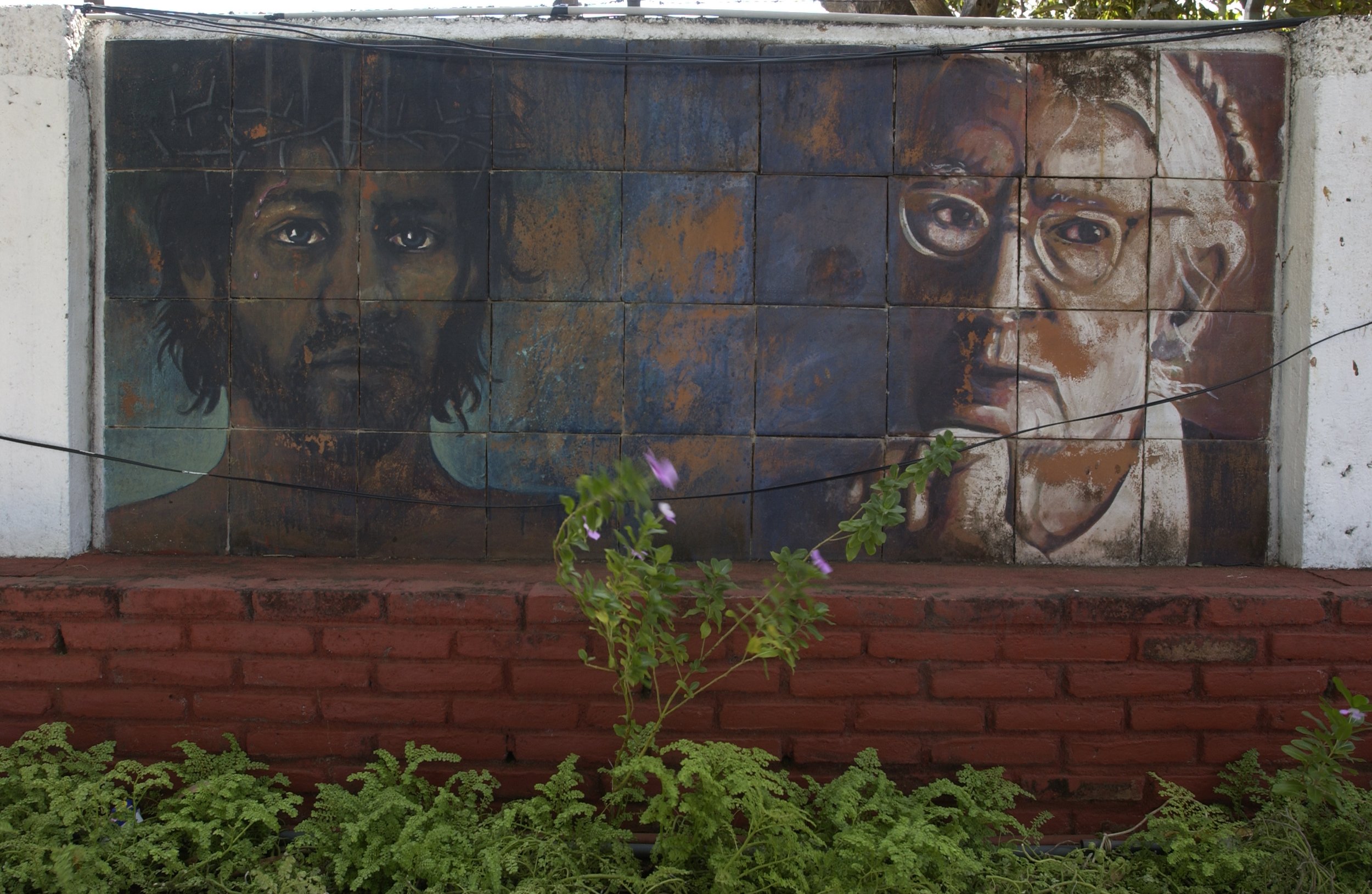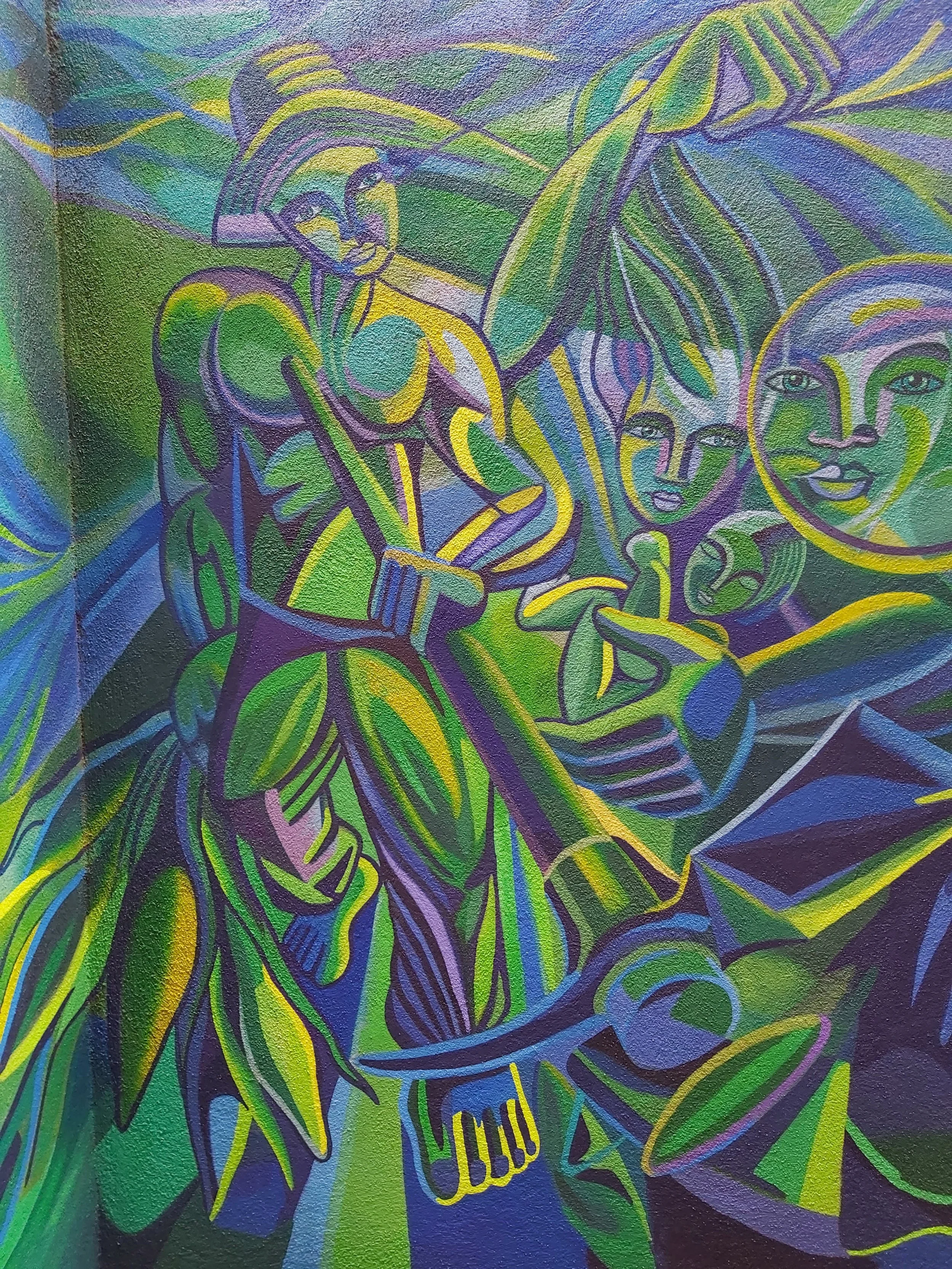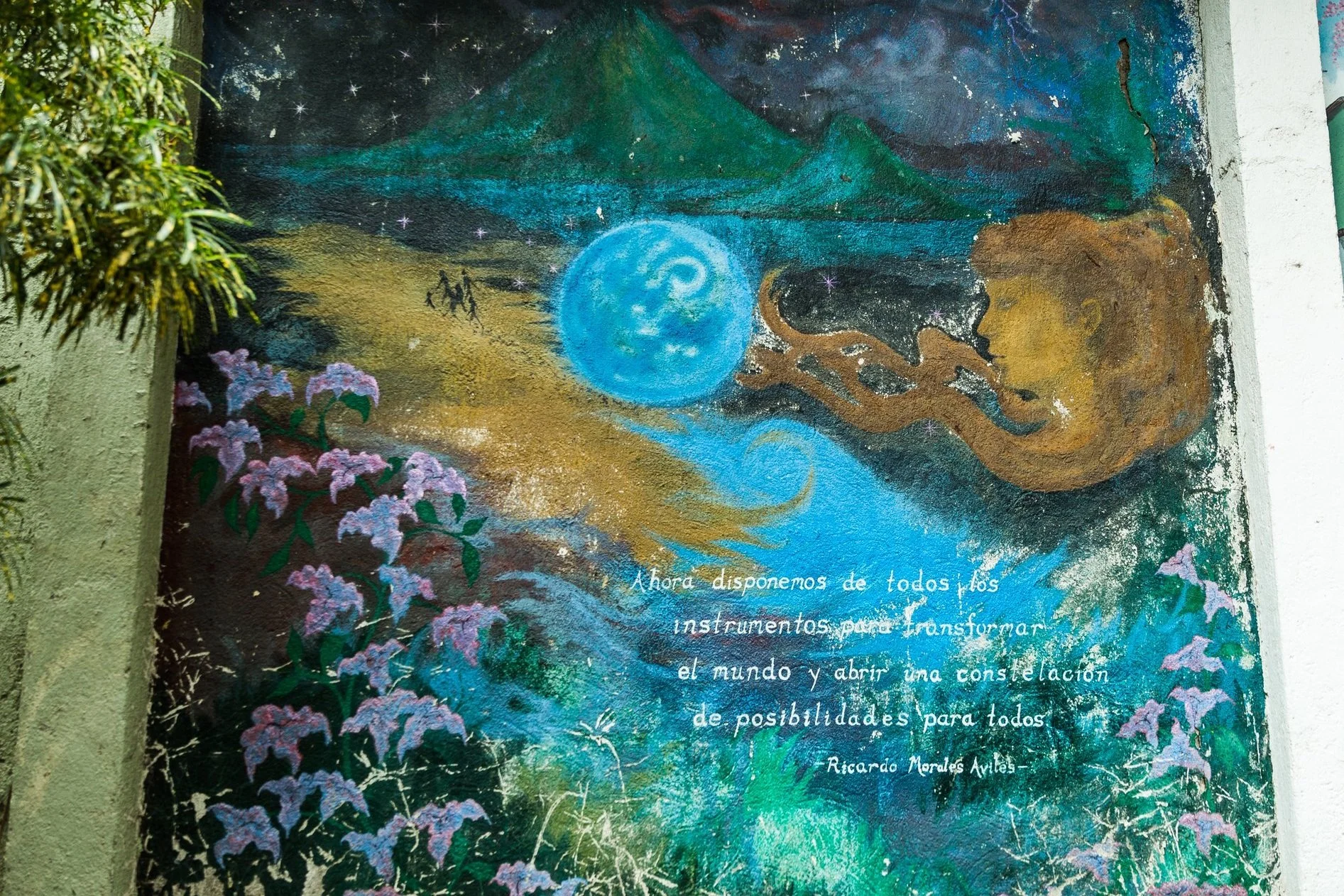Murales en la Casa
“The Community”
Thelma Gómez Flores & Freddy Gaitán Esconcio
1993 painted, repaired in 1993
Primitivist painting in acrylics on concrete wall
This was the first mural painted at the Casa depicting the life of U.S. solidarity worker Benjamin Linder. Ben came to Nicaragua in 1983 to work in solidarity with the Nicaraguan Revolution. He was a juggler, a clown, unicyclist and electrical engineer. In the town of El Cuá, Jinotega, Ben and coworkers installed a hydroelectric system to bring electricity to the village that was being attacked by the Contras at night.
In El Cúa during a measles vaccination campaign, Ben painted himself with red dots and rode his unicycle through the village’s one dirt street while juggling four balls, arriving at the clinic with a passel of kids behind him, who were then lined up to be vaccinated.
“The Community” depicts Revolutionary Nicaragua bustling with home construction, adults in a community meeting, and children playing, As in all the murals about Ben, the dove of peace can be seen in the upper right. Ben’s unicycle is still being used in a small circus and his clown outfit is still used for clowning with children in Nicaragua.
“The Rainbow’s Name is Ben” Part I
AKA “The Belly of the Beast”
Thelma Gómez Flores & Freddy Gaitán Esconcio,1993
Primitivist painting in acrylics on concrete wall
The murals in this series were inspired, in part, by the poem of the same name by Michelle Najlis. Part I depicts Ben’s upbringing in the U.S.: it shows him as a boy sitting on a hillside looking down at a giant red, white and blue beast with a burning city belching smoke inside its belly. The “belly of the beast” is a phrase coined by Cuban writer and revolutionary José Martí while living in the U.S. in the 1880s. Martí saw how the U.S. would become a beast gobbling up its neighbors to the south. “I know the monster,” he wrote, “because I have lived in its lair, and my sling is that of David.”
With Ben in the mural is the dove of peace, to the left the grasshopper representing Hope that appears in all the murals, and above the Beast are the scales of justice.
“The Rainbow’s Name is Ben” Part
Thelma Gómez Flores & Freddy Gaitán Esconcio, 1993
Primitivist painting in acrylics on concrete wall
Part II shows Ben in his native Oregon when he was a child, looking at an electrical storm with his father, learning about electricity. He decided to study electrical engineering, as seen on his backpack after graduating university. In the vision, he is talking to the grasshopper cloud, Hope, about Nicaragua, which she tells him is a country where innocent children are being killed every day.
“Why?” Asks Ben, “Because they love me,” says Hope. There are “people who find hope offensive and think dignity is a crime to be punished.”
“The Rainbow’s Name is Ben” Part III
Thelma Gómez Flores & Freddy Gaitán Esconcio, 1993
Primitivist painting in acrylics on concrete wall
Part III shows Ben in San José de Bocay, working on calculations for another hydroelectric plant. Ben and two Nicaraguan compañeros, Pablo Rosales and Sergio Hernández, were measuring for a weir on April 28, 1987 when they were ambushed by the Contra and shot at point blank range.
In the mural, the grasshopper Hope cries in a madroño tree, the national tree of Nicaragua, and her tears run down to make a rainbow onto Ben Linder’s tomb where flowers grow. Ben was buried in Matagalpa - he was 27 years old.
Ben was killed at the time the Iran-Contra affair was coming to light. Although many other internacionalista solidarity workers had been killed, Ben was the only U.S. citizen killed by the U.S.-funded Contras. There was public outcry over Ben’s death in the U.S. 50,000 Nicaraguans lost their lives in the Contra war.
“Empowerment”
Julie Aguirre
Painted in 1995, restored in 2005/6
Primitivist painting in acrylics on concrete wall
Julie Aguirre is an important Nicaraguan artist from the PRAXIS movement; “Empowerment” is a typical Nicaraguan street scene done in the primitivist style.
Although originally painted in 1995, an oven on the other side of the wall damaged the mural and in 2005/6 the artist restored and modernized it by adding details in the wall graffiti in the street scene. These changes are now like a snapshot of the neoliberal time period.
For example,”6%” is written on the walls along the street, which refers to annual student protests for university funding. Another example is, “No más alzas al agua, luz etc,” which refers to the constant rate hikes in charges for basic services including water, lights and transport at the time. The “No al TLC, Sí a la Vida” refers to protests against the Central American Free Trade Agreement, or CAFTA, which favored big business and was being debated at the time before it passed into law in April 2006.
“Characters in History”
Diederik Grootjans Nijmegen, 1993
Acrylic paints on clay tile
One of the most unusual murals at Casa Ben Linder is “Characters in History,” by Dutch artist Diederik Grootjans. The artist was a volunteer with a sister city project in Masaya when he was invited to paint a mural at Casa Ben Linder by Father Miguel d’Escoto. Grootjans says that when he arrived at the house, Father Miguel already had the clay tiles laid out.
“The choice of the people depicted on the wall of the Casa Ben Linder was made by Father Miquel d‘Escoto. He thought it was a good idea to mix the faces of some great non-violent thinkers with the faces of some normal Nicaraquan people…I painted the tiles, spread out on the grass of the garden.”
Depicted in the mural from right to left: Dr. Martin Luther King, Jr, a Nicaraguan worker woman, Dorothy Day, Jesus Christ, an indigenous Nicaraguan woman, Leon Tolstoy, a Mayagna girl, and Mahatma Gandhi.
The mural style is acrylic on clay tile, using the terracotta color of the tile as shading on the faces.
“The Light They Lit Will Shine Forever”
Gerardo Hernández Arias, 2012 & 2021
Cubist painting in acrylics on concrete wall
This mural is dedicated to Benjamín Linder, Pablo Rosales and Sergio Hernández, assassinated by the Contra in 1987 while they were working on the installation of a hydroelectric power plant; and to their colleagues in the electrification work in El Cuá and San José de Bocay. The theme of the mural is renewable energy, a relevant issue since Nicaragua has extended the electricity grid from 53% national coverage in 2007 to 99% in 2021 and renewable energy sources have increased from 2% in 2007 to 90% in 2021.
In the right panel the darkness is just becoming light with electrification. Above are three angels representing international solidarity with Nicaragua. Benjamin Linder is depicted in the middle connecting the electricity and above is the dove of peace.
In the next panels, the next generation’s inheritance of cleaner energy is represented through play on words - "plant" as a natural plant and as an electric plant with the "leaves" of solar panel, circuit leaves, vine cables, windmill trees, and lily light bulbs. The child represents progress, benefiting from electrical energy, and out of his book is an explosion of colors representing learning. The position of his head suggests he is a poet (Rubén Darío).
The sun is represented by the power button, transmitting the electrical pulse through the cable branches, representing communication and community work. To the extreme left is the depiction of geothermal energy through volcano fire. In the background of the mural you can see the movement of energy - water, wind, sun rays, flames.
“Momotombo”
Payan (young U.S. volunteer), 1994
Acrylic painting on concrete wall
This mural shows Nicaragua’s iconic volcano Mombotombo against the backdrop of the night sky, and a silhouette family following a star-studded path. The quote from Ricardo Morales Avilés reads, “Now we have all the tools at hand to transform the world and open a constellation of possibilities for all.”
Ricardo was a member of the National Directorate of the FSLN, assassinated by Somoza’s national guard in 1973 at 34 years old. He was an intellectual and strategist who was tortured by the National Guard and spent several years in prison after taking part in a bank robbery to get funds for the FSLN. “Ricardo has managed to synthesize the most advanced and complete thinking to date in the panorama of the revolutionary culture of Nicaragua.” – Jaime Wheelock, 20 June 1981.
“Gueguense Petroglyph”
Orlando Sovalbarro, 1994
Bas relief in concrete with acrylic paint
Sobalvarro’s abstract art was a contrast to the mainly realist and primitivist work work done during the Revolution. Sobalvarro, who died in 2009, believed that not only were abstract art and revolution compatible, but that capitalism impedes us from understanding abstract art, something that should be remedied as any form of illiteracy would be. He said, “It is important that the concepts of abstraction be understood by the general public, since the same pictorial qualities apply to painting as to political propaganda.”
